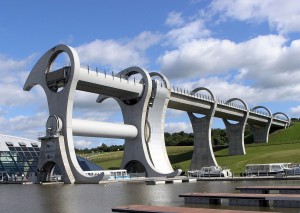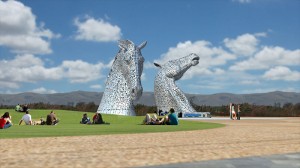Scotland Day Trips #3 – Falkirk Wheel & The Kelpies
Situated in the Forth Valley and equidistant between Edinburgh and Glasgow, Falkirk’s history reaches back at least as far as Roman times. In fact, Falkirk was the Northern frontier of the entire Roman Empire, with the Roman legions either unwilling or unable to go any further. As such, Falkirk has been a rich area for archaeological finds, including a massive hoard of Roman coinage and the oldest tartan cloth every discovered.
In the 18th and 19th century, Falkirk was at the forefront of the Scottish industrial revolution, providing iron and infrastructure to power Scottish industry.
Today, Falkirk is a thriving hub of culture, commerce and entertainment, with its rich history proudly sitting side-by-side with modern achievements.
Two great examples of these modern achievements are the Falkirk Wheel and The Helix, which, as well as being amazing feats of engineering, are among the most popular sports to visit in Scotland.
The Falkirk Wheel
Whilst some might imagine a north of the border version of the London Eye, The Falkirk Wheel is something else entirely.
It is in fact a marvel of modern engineering that tourists flock to see, using modern design to connect two canals that had stood separated since the 1930’s. The Falkirk Wheel is a rotating boat lift – one of only two boat lifts in the whole British Isles, that connects the Forth and Clyde Canal with the Union Canal. In fact, the design of The Falkirk Wheel is entirely unique and there is nothing else like in the entire world.
It opened in 2002, as part of the Millennium Link project and cost a total of £78 million to complete. The overarching aim of the project was to bring central Scotland’s canals back to life and once again connect Glasgow and Edinburgh by waterway. The aim was to bring these historic canals back to life and usefulness, but with a modern flair that reflected the new millennium.
Where there used to a series of 11 locks that allowed canal-going boats to traverse the major difference in height between the two canals, The Falkirk Wheel raises boats a full 24 metres, thereby connecting the two canals once more.
After falling out of use through the 1930’s, the subsequent decades saw the canals fall into ruin, with both canals seeing closure in 1962. By the early 90’s, interest in regenerating the canal was picking up steam and 1997 saw the pledge of £32 million from the Millennium Commission.
The final design of the Falkirk Wheel came about in 1999, after a 20-strong team of architects and designers came up with the now iconic design. The flowing design has rightly earned the structure plaudits for its combination of beauty and function.
As well as the spectacle of The Falkirk Wheel, there are gorgeous walks along the canals themselves, a water play park for any younger visitors and falconry displays, where the star of the show is Marra the sea eagle.
The Wheel is open seven days a week, with the visitor centre and café providing a place for some cake and tea should your feet get tired.
The Helix
Connected by the same project, the Helix is another part of the regeneration program that made the Falkirk Wheel such a massive success.
Further east than the Falkirk Wheel, the Helix came about as a way to remedy the destruction that local canals had undergone during years of neglect. In order to improve the stretch of canal that had limited headroom and accessibility, the Helix project was the recipient of £43 in funding. This would create 870 metres of new canal that would join with the River Carron, along with a new sea lock. Further plans included a tunnel under the M9 motorway and a lift bridge on the A905. The ultimate aim was to take disused, urban land and turn it into something greener and more attractive for all. In addition to reviving the waterway, the plans also include watersports facilities, a large space for open-air performances and 17 miles of walkways and cycle paths.
The most obvious and visible element of the whole Helix project are The Kelpies. Known in Scottish folklore as malevolent spirits that live in lochs and bodies of water, Kelpies often take the form of horses, hence the name of the massive statues. The Helix Kelpies are anything but malevolent, though. These two magnificent structures stand 30m in height, and part of their inspiration comes from the fact that the UK’s biggest Clydesdale breed once came from the Falkirk area.
Weighing in at 300 tonnes each, the Kelpie sculpture is clad in stainless steel. Standing guard over the North Sea entrance to the waterways of Central Scotland, the Kelpies strike amazing figures and are both an amazing piece of art and a feat of engineering. Like the surrounding waterways and the overall, still ongoing, regeneration project, they are the perfect mixture of form and artistry.
Around The Helix, there is plenty to see and do. The lagoon in Helix Park allows for the exploration of the local wetlands, whilst Helix North and South provide amazing woodlands and views of the surrounding country.
The Helix project is still ongoing, with everything set for completion in summer 2014 – just in time to provide alternative entertainment from the September 2014 start date of the Ryder Cup.
